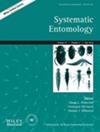发掘地下捕食者:草蛉属(神经翅目:草蛉科)幼虫头部形态及其功能和系统发育意义
IF 4.7
1区 农林科学
Q1 ENTOMOLOGY
引用次数: 2
摘要
草蛉是一种罕见的神经翅目昆虫,其幼虫在地下的生活方式非同寻常。我们用广泛的技术检查了伊托尼·纽曼(Ithone Newman)老龄幼虫的外部和内部头部结构。幼虫的自异形可能与地下生活习性有关,包括紧凑的铲形头部,异常巨大的下颌-上颌柱头,以及C形的头后体。其他的头侧自形畸形包括巨大的X形触手、弯曲的触角和高度发育的垂咽支原体。视觉器官明显简化,但头部两侧保留了一个单一的功能系统,尽管有地下的习惯。与先前的研究相反,在Ithonidae中存在一个发育良好的规则巩膜,可能是二次获得的。出现头腺复体和中毒通道,并有一个意外的附加侧副腺和附加侧通道。毒腺和双通道非常清楚地表明幼虫是捕食者,这与以前假设的植食性习惯相矛盾。与土栖金龟子幼虫相比,其头部结构的显著差异是由于不同的摄食习性和系统发育限制所致。形态上的相似性,如C形的头后身体和适合在土壤中挖洞的强壮的腿,是两个非相关群体地下生活方式的进化相似之处。利用更新后的形态矩阵进行贝叶斯系统发育分析。结果与基于锚定杂交富集数据的系统发育进行了比较。利用从两个数据集估计的系统发育来评估所选性状的进化转化。本文章由计算机程序翻译,如有差异,请以英文原文为准。

Unearthing underground predators: The head morphology of larvae of the moth lacewing genus Ithone Newman (Neuroptera: Ithonidae) and its functional and phylogenetic implications
Moth lacewings (Ithonidae) are a rare group of Neuroptera with an unusual subterranean larval life‐style. We examined external and internal head structures of an older‐instar larva of Ithone Newman with a broad spectrum of techniques. Larval autapomorphies, likely correlated with the subterranean habits, are the compact and shovel‐shaped head, unusually massive mandibular‐maxillary stylets, and a C‐shaped postcephalic body. Other cephalic autapomorphies are the massive X‐shaped tentorium, incurved antennae, and a strongly developed M. verticopharyngalis. The visual organs are distinctly simplified but a single functional stemma on each side of head is retained despite of the subterranean habits. In contrast to previous studies, a well‐developed gular sclerite is present in Ithonidae, possibly a secondary acquisition. A cephalic gland complex and poison channel are present, with an unexpected additional lateral accessory gland and an additional lateral channel. The poison glands and dual channels very clearly indicate that the larvae are predators, contradicting the phytophagous habits formerly postulated. Compared with soil‐inhabiting scarabaeoid beetle larvae, striking differences of head structures are due to different feeding habits and phylogenetic constraints. Morphological similarities like a C‐shaped postcephalic body and strongly developed legs suitable for burrowing in soil are evolutionary parallels associated with the subterranean life‐style in the two non‐related groups. Bayesian phylogenetic analysis was carried out with an updated morphological matrix. The results were compared with a phylogeny based on anchored hybrid enrichment data. The evolutionary transformations of selected characters were evaluated using phylogenies estimated from both datasets.
求助全文
通过发布文献求助,成功后即可免费获取论文全文。
去求助
来源期刊

Systematic Entomology
生物-进化生物学
CiteScore
10.50
自引率
8.30%
发文量
49
审稿时长
>12 weeks
期刊介绍:
Systematic Entomology publishes original papers on insect systematics, phylogenetics and integrative taxonomy, with a preference for general interest papers of broad biological, evolutionary or zoogeographical relevance.
 求助内容:
求助内容: 应助结果提醒方式:
应助结果提醒方式:


